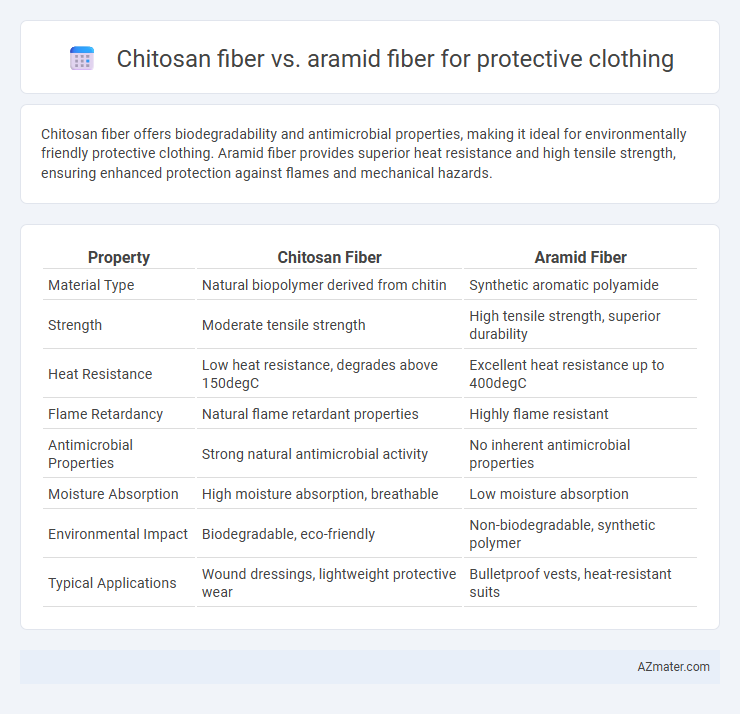Chitosan fiber offers biodegradability and antimicrobial properties, making it ideal for environmentally friendly protective clothing. Aramid fiber provides superior heat resistance and high tensile strength, ensuring enhanced protection against flames and mechanical hazards.
Table of Comparison
| Property | Chitosan Fiber | Aramid Fiber |
|---|---|---|
| Material Type | Natural biopolymer derived from chitin | Synthetic aromatic polyamide |
| Strength | Moderate tensile strength | High tensile strength, superior durability |
| Heat Resistance | Low heat resistance, degrades above 150degC | Excellent heat resistance up to 400degC |
| Flame Retardancy | Natural flame retardant properties | Highly flame resistant |
| Antimicrobial Properties | Strong natural antimicrobial activity | No inherent antimicrobial properties |
| Moisture Absorption | High moisture absorption, breathable | Low moisture absorption |
| Environmental Impact | Biodegradable, eco-friendly | Non-biodegradable, synthetic polymer |
| Typical Applications | Wound dressings, lightweight protective wear | Bulletproof vests, heat-resistant suits |
Introduction: Importance of Protective Clothing
Protective clothing plays a crucial role in minimizing injuries and enhancing safety in hazardous environments across industries such as firefighting, military, and construction. Chitosan fiber, derived from natural biopolymers, offers significant biodegradability, antimicrobial properties, and excellent moisture management, making it suitable for comfort-focused protective garments. Aramid fiber, known for its exceptional strength, heat resistance, and durability, is widely used in ballistic and flame-resistant clothing, providing superior protection against mechanical and thermal hazards.
Overview of Chitosan Fiber
Chitosan fiber, derived from chitin found in crustacean shells, offers biodegradable and antimicrobial properties ideal for protective clothing applications. Its natural origin contributes to excellent moisture-wicking and breathability, enhancing wearer comfort during prolonged use. Compared to aramid fiber, chitosan fiber is less rigid but provides sustainable protection with added bio-functionality against bacteria and fungi.
Overview of Aramid Fiber
Aramid fibers, such as Kevlar and Nomex, are synthetic polymers known for their exceptional strength, heat resistance, and durability, making them ideal for protective clothing in hazardous environments. These fibers offer high tensile strength-to-weight ratios, excellent cut resistance, and thermal stability, allowing garments to withstand extreme temperatures and mechanical stresses. Compared to chitosan fibers derived from natural sources, aramid fibers provide superior performance in impact and flame protection applications essential for military, firefighting, and industrial safety wear.
Mechanical Strength Comparison
Chitosan fiber exhibits moderate tensile strength and elasticity, making it suitable for lightweight protective clothing with antimicrobial benefits but limited impact resistance. Aramid fiber, such as Kevlar, offers exceptional mechanical strength, high tensile modulus, and superior resistance to abrasion and impact, ideal for ballistic and cut-resistant protective gear. The superior durability and structural integrity of aramid fibers significantly outperform chitosan fibers in high-stress and hazardous environments.
Thermal and Flame Resistance
Chitosan fiber offers excellent biodegradability and inherent antimicrobial properties but exhibits limited thermal and flame resistance compared to aramid fibers, which provide superior heat resistance and exceptional flame-retardant capabilities crucial for protective clothing. Aramid fibers, such as Kevlar and Nomex, maintain structural integrity at temperatures up to 500degC and resist ignition and melting, making them ideal for high-heat environments. Chitosan fibers require treatment or blending with flame-retardant additives to approach the thermal protection levels naturally delivered by aramid fibers in firefighting and industrial applications.
Comfort and Breathability
Chitosan fiber offers superior moisture absorption and natural antimicrobial properties, enhancing comfort and breathability in protective clothing compared to aramid fiber. Aramid fiber, while providing exceptional strength and heat resistance, tends to trap heat and moisture, resulting in reduced breathability and comfort. The biodegradable nature of chitosan fiber also contributes to a lighter, more flexible fabric that supports extended wear without discomfort.
Biodegradability and Environmental Impact
Chitosan fiber offers superior biodegradability compared to aramid fiber, breaking down naturally without releasing harmful pollutants, making it an environmentally friendly option for protective clothing. Aramid fiber, known for its high strength and durability, is non-biodegradable and can persist in the environment for decades, contributing to long-term waste concerns. The use of chitosan fiber significantly reduces environmental impact through sustainable sourcing and decomposition, aligning with eco-conscious protective garment manufacturing.
Cost and Availability
Chitosan fiber offers a cost-effective alternative to aramid fiber in protective clothing, with lower raw material expenses due to its biopolymer origin from chitin. Availability of chitosan fiber is more limited and region-dependent, primarily sourced from seafood waste, whereas aramid fiber benefits from well-established global production and supply chains ensuring consistent accessibility. Despite its higher cost, aramid fiber remains widely preferred for protective clothing requiring superior strength and flame resistance, while chitosan fiber's affordability appeals to applications with moderate protection needs.
Applications in Protective Clothing
Chitosan fiber offers antimicrobial properties and biodegradability, making it suitable for protective clothing in healthcare and medical environments where hygiene is critical. Aramid fiber provides exceptional heat resistance, high tensile strength, and durability, making it widely used in firefighting, military gear, and industrial protective clothing. Protective clothing applications prioritize aramid fibers for impact and flame resistance, while chitosan fibers are chosen for antimicrobial protection and skin-friendly comfort.
Future Trends and Innovations
Chitosan fiber is gaining attention in protective clothing for its biodegradable, antimicrobial properties and skin-friendly nature, positioning it as a sustainable alternative to traditional materials. Emerging innovations leverage nanotechnology to enhance chitosan fiber's strength and durability, aiming to match or exceed the high-performance standards of aramid fibers known for superior heat resistance and mechanical strength. Future trends indicate hybrid composites combining chitosan with aramid fibers to optimize protection, comfort, and environmental impact in next-generation protective gear.

Infographic: Chitosan fiber vs Aramid fiber for Protective clothing
 azmater.com
azmater.com